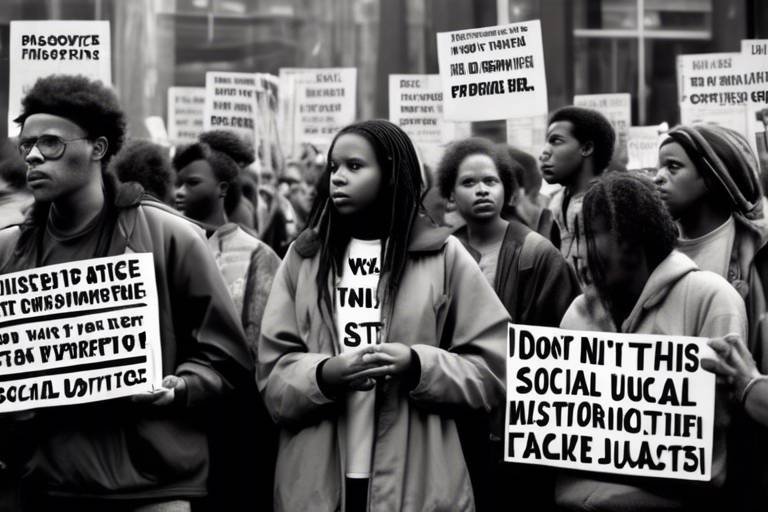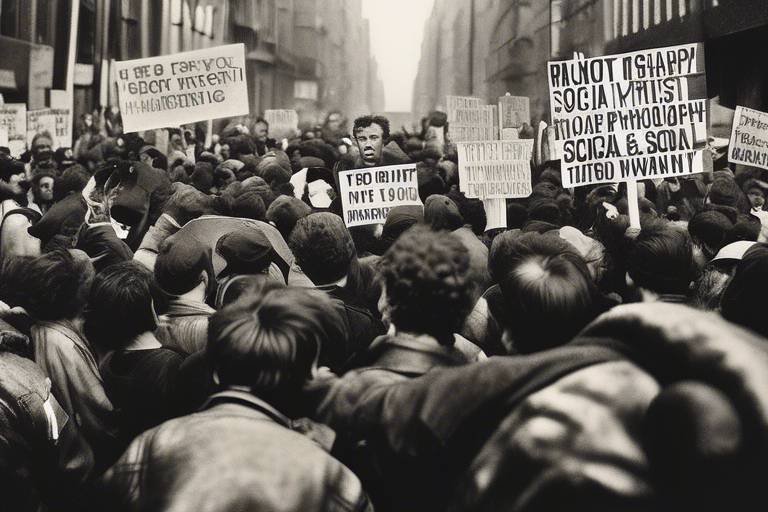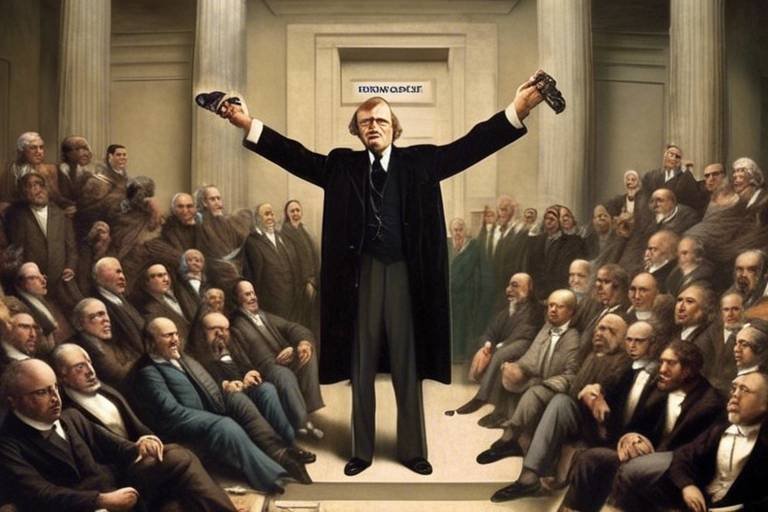Philosophy and the Politics of Vaccine Distribution
The distribution of vaccines is not merely a logistical challenge; it is a profound ethical dilemma that intertwines philosophical principles with political frameworks. As we navigate through the complexities of public health, we must acknowledge that the decisions made regarding who gets vaccinated, when, and how are deeply influenced by underlying moral philosophies. This intersection of philosophy and politics raises critical questions about justice, equity, and the societal obligations we hold towards one another.
At its core, the politics of vaccine distribution challenges us to examine our values as a society. Are we prioritizing the most vulnerable, or are we driven by the interests of the few? The answers to these questions can significantly impact public trust in vaccination programs, which is crucial for achieving herd immunity and managing public health crises effectively. The implications of these decisions ripple through communities, affecting not just individual health but also the broader social fabric.
As we explore the ethical frameworks guiding vaccine distribution, we find ourselves grappling with concepts like utilitarianism, which advocates for actions that maximize overall happiness, and distributive justice, which emphasizes fairness in the allocation of resources. These philosophies are not just academic; they have real-world consequences. For instance, should vaccines be distributed based solely on need, or should we consider factors like age, occupation, or underlying health conditions? The answers are not straightforward and require careful deliberation and cooperation across various sectors of society.
Furthermore, the political landscape surrounding vaccine distribution is equally intricate. Government policies, influenced by lobbying and public opinion, play a pivotal role in shaping vaccine rollout strategies. Policymakers face the daunting task of balancing individual rights with collective responsibility, often leading to contentious debates about mandates and access. In this whirlwind of ethical considerations and political maneuvering, the ultimate goal remains clear: to ensure that vaccines are distributed fairly and effectively, thereby protecting public health.
In conclusion, the philosophy and politics of vaccine distribution are inextricably linked, each influencing the other in profound ways. As we move forward in addressing global health challenges, it is imperative that we engage in thoughtful discussions that encompass both ethical considerations and practical implications. Only by doing so can we hope to create a more equitable and just framework for vaccine distribution that serves all members of society.
- What is the role of ethics in vaccine distribution? Ethics guide decisions on how to allocate vaccines fairly and justly, ensuring that vulnerable populations are prioritized.
- How do political factors affect vaccine access? Government policies, public opinion, and lobbying can significantly influence how and when vaccines are distributed.
- Why is equity important in vaccine distribution? Equitable access ensures that all individuals, regardless of socio-economic status, race, or geography, have the opportunity to receive vaccines.
- What are some global disparities in vaccine access? High-income countries often have better access to vaccines compared to low-income countries, raising ethical concerns about global health equity.

The Ethical Framework of Vaccine Distribution
The distribution of vaccines is not just a logistical challenge; it is a profound ethical dilemma that sits at the crossroads of morality and public health. At the heart of this discussion are several key philosophical principles that guide how we allocate these life-saving resources. Justice, equity, and utilitarianism are three of the most significant frameworks that influence policy decisions and shape public trust in vaccination programs.
Justice in vaccine distribution concerns itself with fairness. It asks the question: Who gets the vaccine first? The principle of justice demands that we consider the needs of the most vulnerable populations, ensuring that those who are at the highest risk receive access before others. This principle is not merely about equal distribution but rather about prioritizing those who are most affected by the disease, such as frontline healthcare workers and individuals with pre-existing health conditions.
Equity takes this a step further by emphasizing that everyone should have access to vaccines, regardless of their socio-economic status, race, or geographical location. In a world where disparities are evident, equity in vaccine distribution becomes a moral imperative. It raises critical questions about how we can ensure that marginalized communities, often hit hardest by health crises, are not left behind. For instance, socio-economic factors play a pivotal role, as individuals in lower-income brackets may face barriers such as transportation issues or lack of information about vaccine availability.
| Ethical Principle | Description |
|---|---|
| Justice | Fair distribution based on need and vulnerability. |
| Equity | Ensuring access for all, regardless of socio-economic status. |
| Utilitarianism | Maximizing overall benefits and minimizing harm. |
Lastly, utilitarianism focuses on the greatest good for the greatest number. This principle suggests that vaccine distribution should aim to maximize overall health benefits, which can sometimes lead to difficult ethical choices. For example, if prioritizing a certain demographic can lead to a significant reduction in disease spread, should that demographic be given preferential access? This is where the ethical waters become murky, as we weigh individual rights against collective benefits.
As we navigate these complex ethical frameworks, it is essential to recognize that the decisions made today will have lasting impacts on public health and trust in vaccination programs. Policymakers must tread carefully, balancing these principles to create a distribution strategy that is not only effective but also ethically sound. The challenge lies not only in the mechanics of distribution but in fostering a sense of community responsibility and trust among the population.
In conclusion, the ethical framework surrounding vaccine distribution is a tapestry woven from various philosophical threads. Understanding these principles can help guide us toward making informed decisions that prioritize both individual rights and collective well-being. The task ahead is not just about getting vaccines into arms but doing so with a deep sense of moral responsibility.
- What is the principle of justice in vaccine distribution? Justice emphasizes fairness and prioritizing those most in need, such as vulnerable populations.
- How does equity differ from equality in vaccine access? Equity focuses on ensuring all individuals have access based on their specific needs, while equality means treating everyone the same.
- Why is utilitarianism important in vaccine distribution? Utilitarianism aims to maximize health benefits for the largest number of people, guiding difficult ethical decisions in public health.

Equity in Vaccine Access
When we talk about , we're diving into a complex web of social, economic, and geographical factors that can either bridge or widen the gap between different populations. Imagine a world where some people have immediate access to life-saving vaccines while others must wait in long lines or, worse, go without altogether. This disparity is not just a statistic; it’s a reality that poses significant challenges to public health and social justice.
At the heart of this issue lies the understanding that equitable access means more than just making vaccines available; it means ensuring that all populations, regardless of their socio-economic status, race, or geographical location, have the same opportunity to receive vaccinations. For instance, consider how urban areas often have better access to healthcare facilities compared to rural regions. This geographic divide can lead to unequal vaccination rates, which can, in turn, affect herd immunity and public health outcomes.
One of the most alarming aspects of vaccine distribution is the impact of socio-economic factors. People living in poverty may struggle with transportation, taking time off work, or even affording the cost of healthcare, which can deter them from getting vaccinated. Additionally, marginalized communities often face systemic barriers that can exacerbate these issues, leading to a cycle of inequity that is difficult to break. This is where the role of governments and organizations becomes crucial in addressing these barriers and implementing strategies to enhance access.
Furthermore, the COVID-19 pandemic has highlighted these disparities on a global scale. Countries with robust healthcare systems and financial resources were able to roll out vaccines quickly, while low-income nations struggled to secure enough doses. The following table illustrates the stark contrast in vaccine distribution between high-income and low-income countries:
| Country Income Level | Vaccines Administered per 100 People |
|---|---|
| High-Income | 150 |
| Upper-Middle-Income | 80 |
| Lower-Middle-Income | 40 |
| Low-Income | 10 |
As we analyze these disparities, it becomes evident that addressing is not merely a question of logistics but a moral imperative. The implications of failing to ensure equitable access extend beyond individual health; they affect community resilience, economic stability, and social cohesion. This is why initiatives aimed at promoting equity, such as mobile vaccination units and community outreach programs, are essential in reaching underserved populations.
In conclusion, achieving equity in vaccine access is a multifaceted challenge that requires a concerted effort from governments, healthcare providers, and communities. By fostering collaboration and understanding the unique barriers faced by different populations, we can work towards a future where everyone has the opportunity to protect themselves and their loved ones through vaccination. After all, in the fight against infectious diseases, no one should be left behind.
- What is vaccine equity? Vaccine equity refers to the fair distribution of vaccines to all populations, ensuring that everyone has access regardless of socio-economic status, race, or location.
- Why is equitable access to vaccines important? Equitable access is crucial for achieving herd immunity and protecting public health, as it prevents outbreaks and ensures that vulnerable populations are protected.
- How can governments improve vaccine access? Governments can improve access by implementing outreach programs, reducing logistical barriers, and ensuring that vaccines are available in underserved areas.

Global Disparities in Vaccine Distribution
When we think about vaccines, we often envision a world where everyone has equal access to life-saving immunizations. However, the reality is starkly different. reveal a troubling truth: not everyone has the same opportunity to protect themselves against infectious diseases. These disparities are not just numbers on a page; they represent real lives affected by decisions made far beyond their reach.
At the heart of this issue lies the significant gap between high-income and low-income countries. For instance, while wealthier nations have secured millions of doses, many low-income countries are left scrambling for supplies. According to recent reports, over 80% of the world's vaccines have been administered in high-income countries, leaving vulnerable populations in poorer regions at risk. This imbalance raises ethical questions about justice and equity in healthcare. Are we, as a global community, doing enough to ensure that vaccines reach those who need them most?
Furthermore, the impact of political and economic factors cannot be ignored. Countries with robust healthcare infrastructures and strong economies are better positioned to negotiate vaccine contracts and secure timely deliveries. In contrast, nations struggling with political instability or economic challenges often find themselves at the back of the line. This situation is exacerbated by manufacturing limitations, export restrictions, and the prioritization of domestic populations in vaccine distribution strategies. Such factors create a vicious cycle where the most vulnerable are left unprotected.
To illustrate the global disparities further, let’s look at a few key statistics:
| Region | Percentage of Population Vaccinated |
|---|---|
| North America | 75% |
| Europe | 70% |
| Asia | 50% |
| Africa | 15% |
| South America | 40% |
This table starkly highlights the challenges faced by different regions. Africa, in particular, stands out with only 15% of its population vaccinated, a figure that starkly contrasts with the 75% in North America. This disparity is not merely a statistic; it translates into lost lives and prolonged suffering.
So, what can be done to address these inequalities? Solutions range from international cooperation to policy changes that prioritize equitable access. Initiatives like COVAX aim to bridge this gap by pooling resources and ensuring that vaccines are distributed based on need rather than wealth. However, the success of such initiatives hinges on the commitment of wealthier nations to share their resources and support global health efforts.
In conclusion, the global disparities in vaccine distribution are a pressing issue that highlights the need for a collective response to ensure that every individual, regardless of their geographical location or economic status, has access to life-saving vaccines. It is a moral imperative that transcends borders and requires a commitment to equity and justice in public health.
- Why are there disparities in vaccine distribution? Disparities arise due to economic, political, and logistical challenges, with wealthier nations often securing more doses than poorer countries.
- What is COVAX? COVAX is a global initiative aimed at equitable access to COVID-19 vaccines, ensuring that vaccines reach those in need, regardless of their country's wealth.
- How can we help address these disparities? Supporting international health organizations, advocating for fair distribution policies, and raising awareness can contribute to reducing vaccine inequities.

Case Studies of Vaccine Distribution
The world has witnessed a myriad of approaches to vaccine distribution, each shaped by unique political landscapes, cultural contexts, and public health philosophies. One striking example is the United States, where the rollout of COVID-19 vaccines was marked by both innovation and controversy. The government implemented a phased distribution strategy, prioritizing healthcare workers and vulnerable populations. However, the decentralized nature of the healthcare system led to significant disparities in access, particularly in rural areas. While some states swiftly vaccinated large portions of their populations, others lagged behind, highlighting the critical role of state policies and infrastructure in determining vaccine availability.
In contrast, Israel emerged as a global leader in vaccine distribution, achieving one of the highest vaccination rates per capita. The Israeli government utilized a centralized healthcare system, allowing for efficient coordination and communication between health authorities and citizens. This enabled rapid deployment of vaccines, with the government securing large quantities from manufacturers early in the pandemic. The success in Israel's vaccine rollout can be attributed to strong public trust in government institutions and a proactive approach to public health, which emphasized the collective benefits of vaccination.
Meanwhile, in India, the situation was markedly different. The country faced immense challenges in vaccine distribution due to its vast population and diverse socio-economic landscape. The government initiated a program called “Vaccination for All”, but logistical hurdles, including transportation issues and vaccine hesitancy, created significant barriers. The disparity in access between urban and rural areas was stark, with urban centers receiving a higher proportion of vaccines compared to remote regions. This situation underscored the need for targeted strategies that consider local contexts and community engagement to improve vaccine uptake.
Another noteworthy case is that of South Africa, which highlights the ethical dilemmas surrounding vaccine distribution. The country initially struggled with vaccine procurement due to limited resources and reliance on global supply chains. However, South Africa's government took a bold step by advocating for the waiver of intellectual property rights on COVID-19 vaccines, aiming to increase local production and accessibility. This case not only illustrates the intersection of public health and politics but also raises questions about global equity and the responsibilities of wealthier nations in supporting vaccine access for lower-income countries.
These case studies reveal that vaccine distribution is not merely a logistical challenge but a complex interplay of ethical considerations, political will, and public trust. Each country’s approach offers valuable lessons on the importance of equitable access, community engagement, and the need for policies that prioritize public health over profit. As we move forward, it is imperative to learn from these experiences to create more effective and just vaccine distribution strategies globally.
- What factors influence vaccine distribution? Vaccine distribution is influenced by a variety of factors, including government policies, healthcare infrastructure, socio-economic conditions, and public trust in health authorities.
- How do case studies help in understanding vaccine distribution? Case studies provide real-world examples of how different countries manage vaccine distribution, highlighting successes and challenges, which can inform better practices in the future.
- What is the role of public trust in vaccine uptake? Public trust is crucial for vaccine uptake, as communities are more likely to participate in vaccination programs when they believe in the efficacy and safety of the vaccines and the integrity of the health system.
- How can global cooperation improve vaccine distribution? Global cooperation, such as initiatives like COVAX, can enhance vaccine distribution by ensuring equitable access, sharing resources, and facilitating the transfer of technology for vaccine production.

International Cooperation and Vaccine Sharing
In an increasingly interconnected world, the need for international cooperation in vaccine distribution has never been more critical. The COVID-19 pandemic has starkly highlighted the disparities in vaccine access across the globe, prompting a collective realization that no nation can truly be safe until every nation is safe. This brings us to the concept of vaccine sharing, which is not just a moral imperative but also a practical necessity for global health.
One of the most significant initiatives aimed at fostering international cooperation is the COVAXto leave no one behind.
However, the journey towards equitable vaccine distribution is fraught with challenges. Many high-income countries have engaged in what is often termed "vaccine nationalism," prioritizing their populations over global needs. This raises ethical questions about the responsibilities of wealthier nations in supporting global health initiatives. For instance, a recent report revealed that while high-income countries had secured enough doses to vaccinate their populations several times over, many low-income countries were still waiting for their first shipments. This disparity is not just a statistic; it represents real lives at stake.
To combat these inequities, international cooperation must extend beyond just sharing vaccines. It should include knowledge transfer, technology sharing, and funding for local production capabilities. Countries can work together to establish manufacturing plants in under-resourced areas, thereby fostering self-sufficiency and resilience against future health crises. By investing in local infrastructure, nations can ensure that they are not solely reliant on external sources for vaccine supply.
Furthermore, the role of international organizations, such as the World Health Organization (WHO), cannot be overstated. These entities help coordinate efforts, provide guidance on best practices, and facilitate discussions among nations. They also play a pivotal role in monitoring vaccine distribution and addressing any potential inequities that arise. For example, the WHO's Access to COVID-19 Tools (ACT) Accelerator has been instrumental in mobilizing resources and support for countries in need.
In conclusion, international cooperation and vaccine sharing are essential components of a successful global health strategy. The pandemic has taught us that we are all interconnected—our health is intertwined with that of others. By prioritizing equitable access and fostering collaboration, we can build a healthier, more resilient world. It's not just about vaccines; it's about our shared humanity.
- What is COVAX? COVAX is a global initiative aimed at ensuring equitable access to COVID-19 vaccines for all countries, regardless of their income level.
- Why is international cooperation important for vaccine distribution? International cooperation is crucial because it helps address disparities in vaccine access, ensuring that all countries can protect their populations against diseases.
- How can high-income countries support low-income countries in vaccine access? High-income countries can support low-income countries by donating vaccines, sharing technology, and funding local production capabilities.
- What role do international organizations play in vaccine distribution? International organizations like the WHO coordinate efforts, provide guidance, and monitor vaccine distribution to ensure equitable access globally.

Public Trust and Vaccine Hesitancy
When it comes to vaccines, public trust is like the foundation of a house; without it, everything else crumbles. Vaccine hesitancy, which refers to the reluctance or refusal to vaccinate despite the availability of vaccines, is a growing concern that can significantly hinder public health efforts. Why do some individuals hesitate? The reasons can be as varied as the colors of a rainbow, ranging from misinformation and fear to cultural beliefs and historical injustices. It's crucial to understand that these hesitations are not merely irrational fears but are often deeply rooted in personal experiences and societal contexts.
One of the most significant factors contributing to vaccine hesitancy is the spread of misinformation. In today's digital age, information travels faster than a speeding bullet, but not all of it is accurate. Social media platforms, while excellent for sharing knowledge, can also be breeding grounds for conspiracy theories and false narratives about vaccines. For instance, claims that vaccines cause autism or that they contain harmful substances can create unnecessary fear. These misconceptions can lead to a lack of trust in healthcare providers and public health policies.
Moreover, historical injustices play a significant role in shaping perceptions about vaccines, especially among marginalized communities. Events like the Tuskegee Syphilis Study have left a lingering distrust towards medical institutions. People often ask themselves, “Why should I trust a system that has historically exploited my community?” This skepticism is not unfounded; it is a reflection of a painful legacy that cannot be overlooked. Addressing these issues requires a nuanced approach that acknowledges past wrongs while fostering a dialogue about the benefits of vaccination.
Informed consent is another critical aspect of public trust in vaccination programs. Individuals want to feel empowered in their healthcare decisions, and when they are not adequately informed about the benefits and risks of vaccines, they may choose to opt-out. This is where healthcare providers can play a pivotal role. By engaging in open conversations, answering questions, and providing transparent information, they can help demystify the vaccination process. It's essential for healthcare professionals to listen actively to the concerns of patients, validating their feelings while providing factual information.
To combat vaccine hesitancy effectively, public health campaigns must be tailored to address the specific concerns of different communities. Here are some strategies that can enhance public trust:
- Community Engagement: Involving community leaders and trusted figures in vaccination campaigns can bridge the gap between healthcare providers and the public.
- Education Initiatives: Providing clear, evidence-based information about vaccines can dispel myths and reduce fears.
- Transparency: Openly discussing vaccine development processes, including trials and safety measures, can build confidence.
Ultimately, fostering public trust requires a collective effort from healthcare providers, policymakers, and communities. By addressing the root causes of vaccine hesitancy, we can create an environment where individuals feel safe and informed enough to make the decision to vaccinate. In doing so, we not only protect individual health but also contribute to the greater good of public health.
Q1: What is vaccine hesitancy?
A1: Vaccine hesitancy is the reluctance or refusal to vaccinate despite the availability of vaccines, often influenced by misinformation, fear, and cultural beliefs.
Q2: How can misinformation about vaccines be addressed?
A2: Misinformation can be countered through education, community engagement, and transparent communication from healthcare providers.
Q3: Why is public trust important for vaccination programs?
A3: Public trust is essential because it influences individuals’ willingness to vaccinate, which is crucial for achieving herd immunity and protecting public health.
Q4: What role do healthcare providers play in building vaccine trust?
A4: Healthcare providers can build trust by engaging in open conversations, addressing concerns, and providing factual information about vaccines.

Political Influences on Vaccine Policy
The landscape of vaccine distribution is not merely a matter of health; it is deeply intertwined with politics. The **decisions made by government officials** and policymakers significantly shape how vaccines are distributed, who gets access, and when. This intersection of politics and public health raises critical questions: How do governmental priorities influence vaccine rollout? Are certain populations favored over others based on political agendas? Understanding these dynamics is essential for grasping the complexities of vaccine distribution.
Government policies play a pivotal role in establishing the framework within which vaccines are distributed. For instance, **funding allocations** can directly affect vaccine availability. When governments prioritize healthcare funding, it often leads to more comprehensive vaccination programs. Conversely, when budgets are tight, vaccine initiatives may suffer. This is especially true in regions where **political instability** can disrupt health services, leaving vulnerable populations at risk. The **political will** to invest in public health initiatives is crucial for effective vaccine distribution.
Moreover, the influence of lobbying cannot be understated. Pharmaceutical companies, advocacy groups, and other stakeholders often exert significant pressure on policymakers. This can result in policies that favor specific vaccines or distribution methods, sometimes prioritizing profits over public health. For example, the recent pandemic saw intense lobbying efforts aimed at securing favorable conditions for vaccine manufacturers. This raises ethical concerns about **transparency** and **accountability** in vaccine distribution policies.
Public opinion also plays a critical role in shaping vaccine policy. Policymakers are keenly aware that their decisions are often scrutinized by the public, and as such, they may tailor their strategies to align with public sentiment. This can lead to a **reactive approach** rather than a proactive one, where decisions are made based on current public opinion rather than long-term public health goals. The challenge lies in balancing **individual rights** with the collective responsibility of protecting community health. In times of crisis, such as a pandemic, this balance becomes even more delicate.
Additionally, the political ideologies of those in power can influence vaccine distribution strategies. For instance, **liberal governments** may adopt more inclusive policies that prioritize equitable access, while **conservative administrations** might focus on market-driven solutions. This ideological divide can create disparities in how vaccines are allocated and who benefits from them. It’s a classic case of how **politics and health intersect**, often with profound implications for public health outcomes.
To illustrate these points, consider the following table that summarizes the different political influences on vaccine policy:
| Political Influence | Description | Impact on Vaccine Distribution |
|---|---|---|
| Government Policies | Regulations and funding decisions made by government officials. | Can enhance or limit vaccine access based on budget allocations. |
| Lobbying | Pressure from pharmaceutical companies and advocacy groups. | May lead to favoritism towards specific vaccines or manufacturers. |
| Public Opinion | The collective sentiment of the population regarding vaccines. | Can influence the timing and focus of vaccination campaigns. |
| Political Ideologies | Beliefs that shape how governments approach public health. | Can create disparities in access and prioritization of vaccine distribution. |
In conclusion, the political influences on vaccine policy are multifaceted and complex. They intertwine with ethical considerations, public trust, and the overall effectiveness of vaccination efforts. As we navigate through future health crises, it is imperative to remain vigilant about these influences to ensure that vaccine distribution is fair, equitable, and rooted in the best interests of public health.
- How do government policies impact vaccine distribution?
Government policies determine funding, regulations, and priorities, which directly affect how vaccines are distributed. - What role does lobbying play in vaccine policies?
Lobbying can influence which vaccines are prioritized and how policies are structured, sometimes at the expense of public health. - How does public opinion affect vaccine rollout?
Policymakers often respond to public sentiment, which can lead to reactive rather than proactive health strategies. - How do political ideologies shape vaccine access?
Different political beliefs can lead to varying approaches to public health, affecting who receives vaccines and when.

The Role of Government in Vaccine Distribution
The government plays a pivotal role in the distribution of vaccines, acting as both a facilitator and regulator in the process. When a new vaccine is developed, it’s not just the science behind it that matters; the way it gets into the arms of the public is equally crucial. Governments are responsible for creating policies that ensure vaccines are produced, distributed, and administered efficiently. This involves a delicate balance between public health needs and logistical capabilities, all while navigating the often turbulent waters of politics.
One of the primary responsibilities of the government is to establish a clear vaccination strategy. This includes setting priorities for who gets vaccinated first, especially during times of limited supply. For instance, during a pandemic, frontline workers and vulnerable populations might be prioritized. But how do governments decide these priorities? They often rely on data-driven approaches that take into account factors like age, health conditions, and socio-economic status. Yet, the challenge lies in ensuring that these decisions are made transparently and equitably, so that public trust is maintained.
Moreover, governments must ensure that vaccines are accessible to all segments of the population. This means addressing barriers to access such as cost, transportation, and availability. In many cases, it requires collaboration with local health departments, non-profits, and even private sectors to create a comprehensive distribution network. For example, mobile vaccination units can be deployed to reach remote areas where healthcare facilities are scarce. This approach not only helps in increasing vaccination rates but also demonstrates the government’s commitment to equity in public health.
Another critical aspect is the regulatory framework that governs vaccine approval and distribution. Governments are tasked with ensuring that vaccines are safe and effective before they are rolled out to the public. This involves rigorous testing and evaluation processes, which can sometimes lead to public skepticism regarding vaccine safety. To combat this skepticism, governments must engage in effective communication strategies that educate the public about the benefits of vaccination while addressing concerns transparently. Utilizing social media, public service announcements, and community outreach programs can significantly enhance public understanding and acceptance.
In addition to these responsibilities, the government also plays a crucial role in funding vaccine research and development. By investing in innovative technologies and partnerships with pharmaceutical companies, governments can expedite the creation of new vaccines. This was particularly evident during the COVID-19 pandemic, where governments worldwide allocated billions to support vaccine development initiatives. Such investments not only lead to rapid advancements in vaccine technology but also ensure that vaccines remain affordable and accessible to the general public.
To summarize, the role of government in vaccine distribution is multi-faceted and complex. It involves strategic planning, equitable access, regulatory oversight, public education, and funding. Each of these elements is vital in ensuring that vaccines reach those who need them most and that public trust in vaccination efforts is upheld. The effectiveness of these actions can ultimately determine the success of vaccination programs and, by extension, the health of the population.
- What is the government's role in vaccine distribution?
The government is responsible for creating policies, ensuring equitable access, regulating vaccine safety, and funding research and development. - How do governments prioritize vaccine distribution?
Governments use data-driven approaches to prioritize vulnerable populations and frontline workers during limited supply. - What measures are taken to ensure equitable access to vaccines?
Governments collaborate with local health departments and organizations to address barriers like cost and transportation. - How does the government address vaccine hesitancy?
Effective communication strategies, including education and transparency, are employed to build public trust and acceptance.

Political Ideologies and Public Health
When we dive into the realm of political ideologies and their impact on public health, we find ourselves navigating a complex landscape filled with competing values and beliefs. At the heart of this discussion is a fundamental question: should the government prioritize individual freedoms or the collective good? This dilemma often manifests in the way vaccines are distributed and how public health policies are crafted. For instance, in systems that lean towards libertarianism, there is a tendency to emphasize personal choice and autonomy. Here, the narrative often revolves around the idea that individuals should have the freedom to make their own health decisions, even if it means opting out of vaccination. This can lead to challenges in achieving herd immunity, as a significant portion of the population may choose not to vaccinate.
On the flip side, more collectivist ideologies, such as socialism, advocate for a stronger role of the state in ensuring public health. In these frameworks, the government is seen as a guardian of the population's well-being, often implementing policies that mandate vaccinations to protect the community. This approach raises its own set of ethical questions, particularly regarding the balance between individual rights and societal responsibility. How do we ensure that everyone contributes to the health of the community without infringing on personal freedoms? The answer lies in a delicate balance, often requiring transparent communication and community engagement to foster understanding and acceptance of public health measures.
Furthermore, the political environment can greatly influence public perception of vaccines. For instance, in countries where populist movements gain traction, misinformation can spread rapidly, leading to increased vaccine hesitancy. Here, political leaders may prioritize their agendas over scientific consensus, creating an atmosphere of distrust. In contrast, nations with a strong tradition of evidence-based policy-making often see higher vaccination rates, as public health measures are grounded in scientific research and collective input from health experts.
To illustrate the varying approaches to vaccine distribution influenced by political ideologies, consider the following table that summarizes key differences:
| Political Ideology | Approach to Public Health | Impact on Vaccine Distribution |
|---|---|---|
| Libertarianism | Emphasis on individual choice | Potentially lower vaccination rates due to personal opt-out |
| Socialism | State responsibility for health | Higher vaccination rates through mandates |
| Populism | Focus on popular sentiment | Increased vaccine hesitancy due to misinformation |
| Evidenced-based Governance | Policy grounded in science | Higher vaccination rates through trust in health experts |
In conclusion, the intersection of political ideologies and public health is a dynamic and often contentious arena. As we navigate through various ideologies, it becomes evident that the approach to vaccine distribution is not merely a logistical challenge but a reflection of deeper societal values. The ongoing dialogue about individual rights versus collective responsibility will undoubtedly shape the future of public health policies, especially in the context of vaccination. Ultimately, fostering a culture of trust, transparency, and mutual respect among all stakeholders is crucial for the success of vaccination programs and the promotion of public health.
- What role do political ideologies play in vaccine distribution?
Political ideologies influence how governments approach public health, affecting policies on vaccination mandates and individual freedoms. - How can trust in vaccines be improved?
Building trust requires transparent communication, community engagement, and the involvement of health experts in decision-making. - What are the consequences of vaccine hesitancy?
Vaccine hesitancy can lead to lower vaccination rates, undermining herd immunity and increasing the risk of disease outbreaks. - How do collective and individual rights intersect in public health?
Balancing collective responsibility for public health with individual rights is crucial, often requiring careful policy crafting and community dialogue.
Frequently Asked Questions
- What ethical principles guide vaccine distribution?
The ethical principles that guide vaccine distribution include justice, equity, and utilitarianism. Justice ensures that all individuals have fair access to vaccines, while equity focuses on addressing disparities based on socio-economic factors. Utilitarianism emphasizes maximizing the overall benefit to society, which can sometimes lead to tough decisions about prioritizing certain groups over others.
- How does socio-economic status affect vaccine access?
Socio-economic status plays a significant role in vaccine access. Individuals from lower-income backgrounds may face barriers such as limited healthcare access, transportation issues, and lack of information. These factors can create disparities in vaccination rates, ultimately impacting public health and exacerbating social inequalities.
- What are the global disparities in vaccine distribution?
Global disparities in vaccine distribution are stark, with high-income countries often securing vaccines much faster than low-income nations. This inequity raises profound ethical questions about global justice and responsibility. Initiatives like COVAX aim to address these disparities by promoting equitable access to vaccines across borders.
- How does public trust influence vaccine uptake?
Public trust is crucial for vaccine uptake. When communities trust the healthcare system and the information provided, they are more likely to participate in vaccination programs. Factors such as transparency, community engagement, and addressing misinformation are vital for building that trust and reducing vaccine hesitancy.
- What role does government play in vaccine distribution?
Governments play a pivotal role in vaccine distribution by establishing policies, securing funding, and ensuring that vaccines are available to all populations. Their actions can significantly impact the efficiency and equity of vaccine rollout, making it essential for policymakers to prioritize public health in their decisions.
- How do political ideologies affect public health approaches?
Political ideologies can shape public health approaches by influencing how governments balance individual rights against collective responsibility. For instance, some ideologies may prioritize personal freedom, potentially leading to lower vaccination rates, while others may emphasize community health, advocating for mandatory vaccination policies to protect public welfare.



















